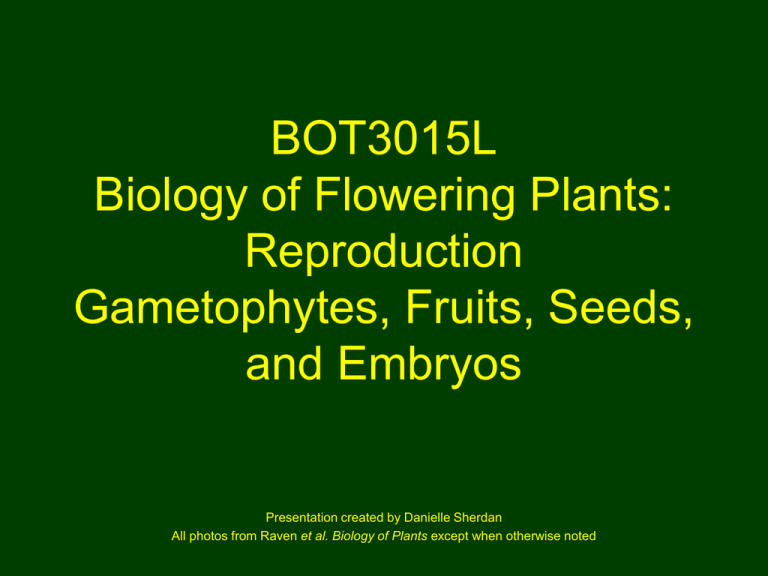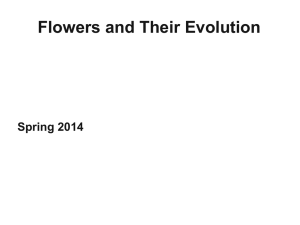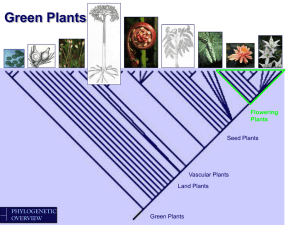
BOT3015L
Biology of Flowering Plants:
Reproduction
Gametophytes, Fruits, Seeds,
and Embryos
Presentation created by Danielle Sherdan
All photos from Raven et al. Biology of Plants except when otherwise noted
Today
• Alternation of generations (sporic meiosis)
• Alternation of generations in angiosperms
• Angiosperm gametophytes
• microgametophyte
• megagametophyte
• Double fertilization** (endosperm and embryo)
• Seeds
• Fruits**
**Distinguishing characteristics of angiosperms
Angiosperm life cycle
Last week
This week
In the next weeks
From Outlaw’s lecture series
Today
• Alternation of generations (sporic meiosis)
• Alternation of generations in angiosperms
• Angiosperm gametophytes
• microgametophyte
• megagametophyte
• Double fertilization** (endosperm and embryo)
• Seeds
• Fruits**
**Distinguishing characteristics of angiosperms
Microsporogenesis in the anther
Microsporocyte (a.k.a.
microspore mother cells)
undergo meiosis to produce
four dissimilar microspores.
Lily anther, immature, cross section
Formation of microspores & male gametes.
Microspore
mother cell
“housekeeping” for sex
Mitosis of
generative nucleus
From Outlaw’s lecture series
Entire Male Gametophyte (angiosperms):
**1 round of mitosis to yield 2 nuclei (generative + vegetative).
**The generative nucleus divides again mitotically to yield 2 sperm.
Mature microgametophyte
Sperm cells
Mature pollen
Mature anther
telegraph plant
lily
The protective wall and efficient dispersal of microgametophytes are two
adaptations to terrestrial life (compare to flagellated gametes being released)
Note: Some pollen are shed before the generative cell divides mitotically to
produce the two sperm cells, some pollen are shed after (as shown above)
Pollination to fertilization
pollen tube growth
Angiosperm life cycle
From Outlaw’s lecture series
Today
• Alternation of generations (sporic meiosis)
• Alternation of generations in angiosperms
• Angiosperm gametophytes
• microgametophyte
• megagametophyte
• Double fertilization** (endosperm and embryo)
• Seeds
• Fruits**
**Distinguishing characteristics of angiosperms
Megasporogenesis within the ovule within the
ovary
The swollen base of the carpel (megasporophyll) is the ovary.
Ovules form on the inside and remain attached for nutrition. The
megaspore mother cell (2n) is inside the ovule; it gives rise
(through meiosis) to the megagametophyte, which completes its
entire life within the ovule wall (later, seed coat).
From Outlaw’s lecture series
Formation of megaspores & female gametes.
3 degenerate
Megaspore Meiosis
mother cell
a.k.a. polar nuclei
Mitosis
Mitosis
Mitosis
Fertilization
—next slide
From Outlaw’s lecture series
Entire Female Gametophyte (angiosperms):
**3 round of mitosis to yield 8 nuclei .
**Egg near micropylar end of female gametophyte.
**Polar nuclei in the center of female gametophyte.
Megagametophyte
(Before migration of polar nuclei to center)
**
Megagametophyte
****
8-nucleate megagametophyte
within ovule of lily (only 6 nuclei are
visible in this section)
Angiosperm life cycle
From Outlaw’s lecture series
Today
• Alternation of generations (sporic meiosis)
• Alternation of generations in angiosperms
• Angiosperm gametophytes
• microgametophyte
• megagametophyte
• Double fertilization** (endosperm and embryo)
• Seeds
• Fruits**
**Distinguishing characteristics of angiosperms
Double
Fertilization
Second fertilization event: 1
male gamete (n) + 2 female
gametes (n + n) = endosperm
(3n)
r
t
i
l
i
z
a
t
i
o
n
From Outlaw’s lecture series
Ordinary fertilization event: 1
male gamete (n) + 1 female
gamete (n) = zygote (2n)
Megagametophyte after double
fertilization
Today
• Alternation of generations (sporic meiosis)
• Alternation of generations in angiosperms
• Angiosperm gametophytes
• microgametophyte
• megagametophyte
• Double fertilization**
• Seeds
• Fruits**
**Distinguishing characteristics of angiosperms
Seed development
immature
dicot - two cotyledons
mature
Three
tissue
systems:
Dermal
Vascular
Cortex or Ground
All cells of the plant are
part of these three
systems and originate at
meristems
. . . A reminder that endosperm is formed in all angiosperms, but does not
persist in dicots. In dicots, cotyledons are the primary source of nutrients for
germination.
Seed
development
typical monocot (wheat)
seed with ovary wall (pericarp)
Monocots have one cotyledon
that matures during germination
Source of nutrition for seed
germination: endosperm
(compare to dicot)
Angiosperm life cycle
From Outlaw’s lecture series
Today
• Alternation of generations (sporic meiosis)
• Alternation of generations in angiosperms
• Angiosperm gametophytes
• microgametophyte
• megagametophyte
• Double fertilization** (endosperm and embryo)
• Seeds
• Fruits**
**Distinguishing characteristics of angiosperms
Angiosperm seeds are in
a vessel
All seeds have a seed coat
(plus embryo & nutritive
supply)
This simple fruit is derived from
one carpel with several ovules
and has marginal/parietal
placentation.
From Outlaw’s lecture series
Reminder: carpels are modified leaves Pisum (Leguminoseae family
Fruit types
• Simple - one carpel or fused carpels
• Fleshy
• Simple - one carpel or fused carpels
•Berry - each carpel contains many seeds, inner
• Berry
layer of carpel fleshy
• Drupe
•Drupe
• Pome
•Pome
• Aggregate
• Dry
• Multiple
•Dehiscent
•Indehiscent
• Aggregate
• Multiple
Simple
Each carpel contains many seeds, inner layer of carpel fleshy
Legumes are examples of simple, dry (for dispersal) fruits
Marginal placentation
Recall that the carpel is a
modified leaf (megasporophyll)
Pisum (Leguminoseae family)
Pepo - a type of berry
a simple (not multiple or aggregate), fleshy fruit
Each carpel contains many seeds, inner layer of carpel fleshy
Parietal placentation
carpel
Arrows:
attachment
to nutrition
source (old
sporophyte)
From Bill Outlaw’s garden
Cucumis (Cucurbitaceae family)
Berry
Each carpel contains many seeds, inner layer of carpel fleshy
Examples: citrus, tomato, grape
Axile placentation
carpel
From Bill Outlaw’s garden
Fruit types
• Simple - one carpel or fused carpels
• Fleshy
•Berry - each carpel contains many seeds, inner
layer of carpel fleshy
•Drupe
•Pome
• Dry
•Dehiscent
•Indehiscent
• Aggregate
• Multiple
Drupe
Outer fleshy layer; stone-like inner layer from ovary wall
Examples: Peach, olive
Ovary
Seed within pit (ovary wall)
Photo by Bill Outlaw
Prunus (Rosaceae family)
Fruit types
• Simple - one carpel or fused carpels
• Fleshy
•Berry - each carpel contains many seeds, inner
layer of carpel fleshy
•Drupe
•Pome
• Dry
•Dehiscent
•Indehiscent
• Aggregate
• Multiple
Pome
Outer fleshy layer from fused sepals and petals. Core derived
from ovary
Example: pear
Carpel
Ovary
Fused sepals
and petals
Placentation type?
From Bill Outlaw’s garden
Pyrus (Rosaceae family)
Axile
Fruit types
• Simple - one carpel or fused carpels
• Fleshy
•Berry - each carpel contains many seeds, inner
layer of carpel fleshy
•Drupe
•Pome
• Dry
•Dehiscent
•Indehiscent
• Aggregate - separate carpels of one flower
• Multiple
Aggregate
Separate carpels of one gynoecium (gyno=woman, ecium=house)
Examples: strawberry, raspberry
Mock strawberry
aggregate of
achenes (small,
single-seeded fruits)
One flower with large
receptacle (base of flower)
and many carpels, each
produces a fruit; thus, we
eat the receptacle and the
fruits are often mistaken for
seeds
Rosaceae family
Photo by Bill Outlaw
Fruit types
• Simple - one carpel or fused carpels
• Fleshy
•Berry - each carpel contains many seeds, inner
layer of carpel fleshy
•Drupe
•Pome
• Dry
•Dehiscent
•Indehiscent
• Aggregate
• Multiple - gynoceia of more than one flower;
inflorescence
Multiple fruit
Gynoecia of more than one flower, inflorescence
Examples: mulberry, pineapple
Notice the
remnants of the
carpel of each
flower of the
inflorescence
Morus (Moraceae family)
From Bill Outlaw’s garden
Multiple fruit
Gynoecia of more than one
flower, inflorescence
Examples: mulberry, pineapple
Ananas (Bromeliaceae family)
Photo from Iowa State University, department of Ecology, Evolution, and Organismal Biology
??
Type of fruit?
Type of placentation?
Single carpel or fused carpels?
One or many ovules per carpel?
Bonus: If this flower
has a superior ovary,
where would you find
remnants of the
petals?
Of the style?
Capsicum (Solanaceae family)
From Bill Outlaw’s garden
??
Type of fruit?
Type of placentation?
Number of carpels?
Number of flowers that
produced this fruit?
One or many ovules per
carpel?
Photo by Outlaw
Malus (Rosaceae family)
Pawpaw for fun
From Bill Outlaw’s garden
Pawpaw (Annonaceae family)
Largest edible fruit native to North America
A berry with marginal placentation
Fruit types
• Simple - one carpel or fused carpels
• Fleshy
•Berry - each carpel contains many seeds, inner
layer of carpel fleshy
•Drupe
•Pome
• Dry
•Dehiscent
•Indehiscent
• Aggregate
• Multiple
Fruits and seed dispersal
dehiscence
Griffonia
(Leguminoseae family)
Albizzia
Leguminoseae family)
Pisum
(Leguminosae family)
Used by Mendel for his
studies of genetics
Type of fruit?
Type of placentation?
Fruits and seed
dispersal
water
Cocus (Arecaceae family)
Fruit types
• Simple - one carpel or fused carpels
• Fleshy
•Berry - each carpel contains many seeds, inner
layer of carpel fleshy
•Drupe
•Pome
• Dry
•Dehiscent
•Indehiscent
• Aggregate
• Multiple
Fruits and seed dispersal
wind
Examples of achenes as well
Relative of dandelion
Agoseris (Asteraceae family)
Tumbleweed. The plant
breaks off from its roots and
blows across open terrain,
scattering seeds as it rolls
Salsola (Chenopodiaceae family)
Fruits and seed dispersal
animals by attachment
All the various seeds that
stick on your socks and
pants stick to animal fur
Harpagophytum (Pedaliaceae family)
Xanthium (Asteraceae family)
Independent Germination
Experiment
1. Be sure to design an experiment with repetition
and control.
2. Turn in a design with the experimental question,
hypothesis, and design details including
measurements you will take.
3. You are required to bring your germinated
seedlings when the report is due, so better not to
delay beginning your experiment.










